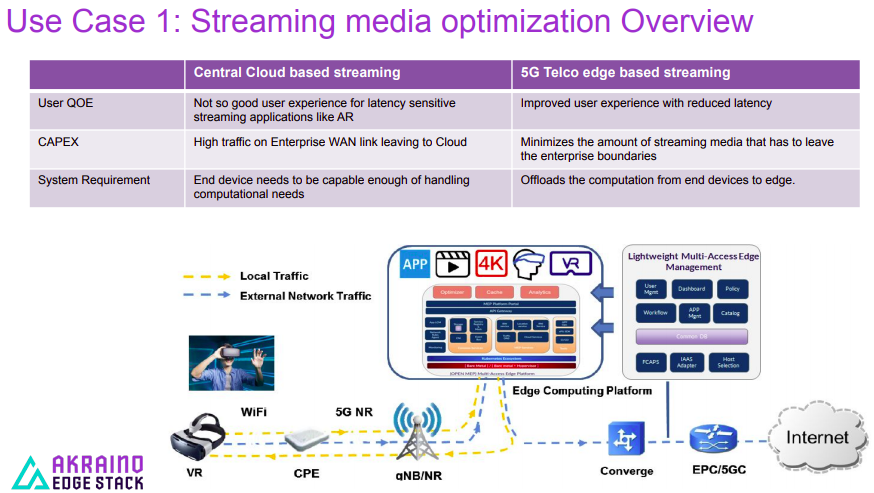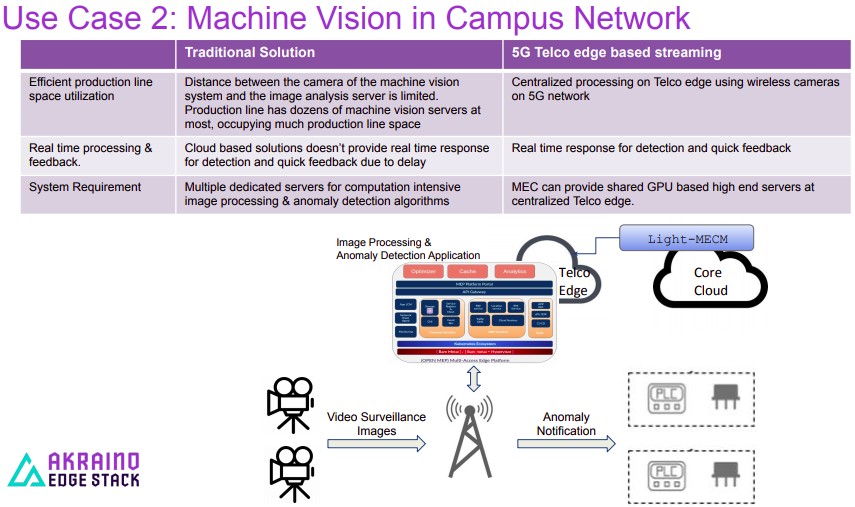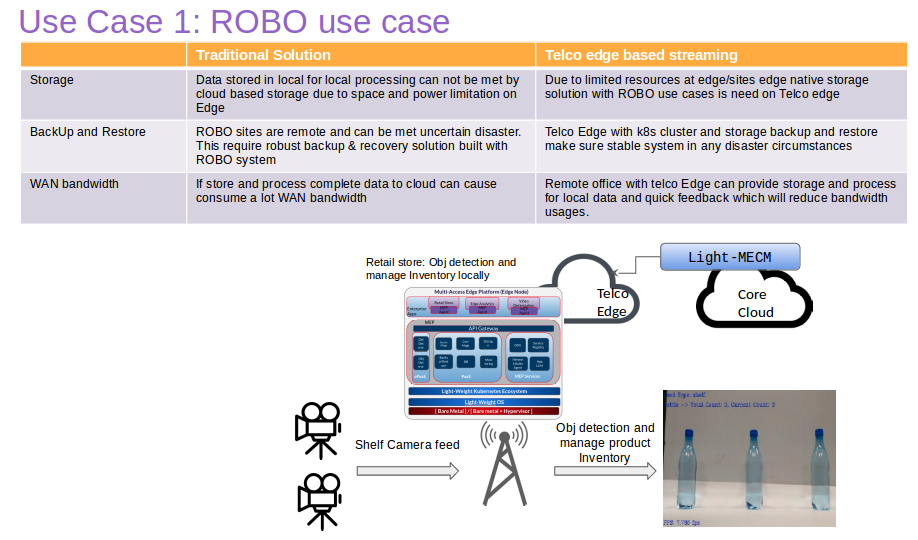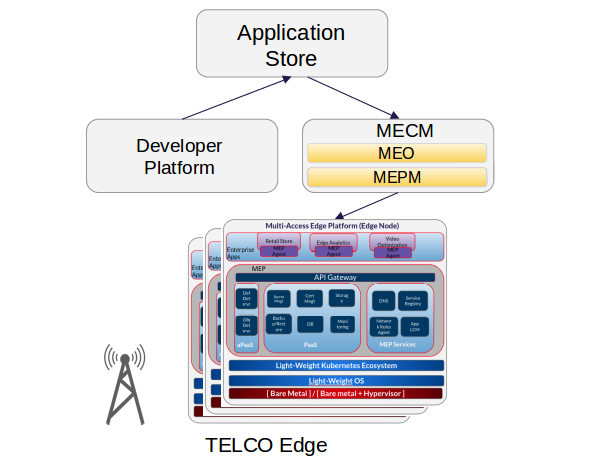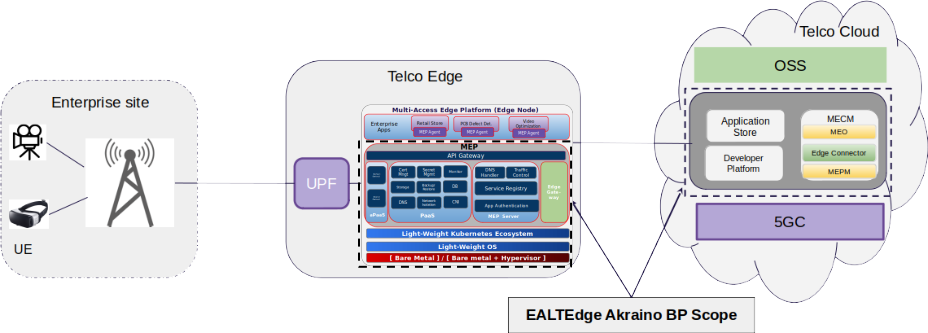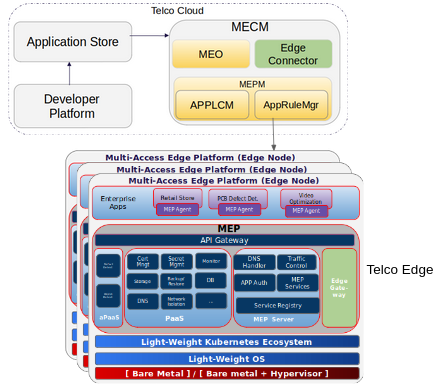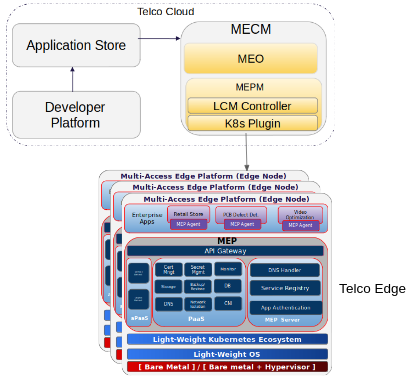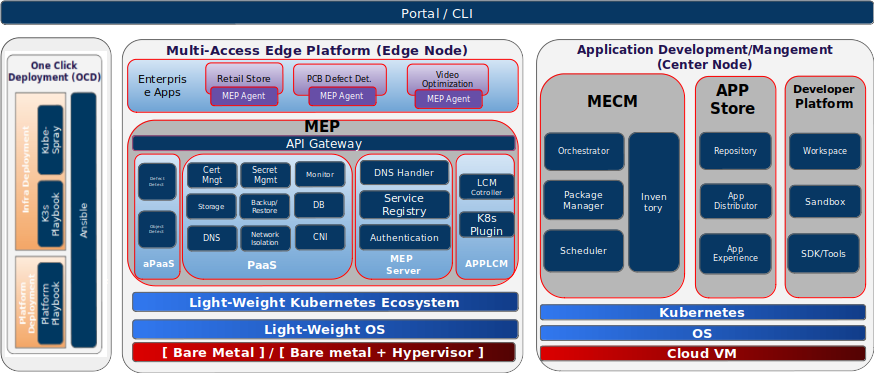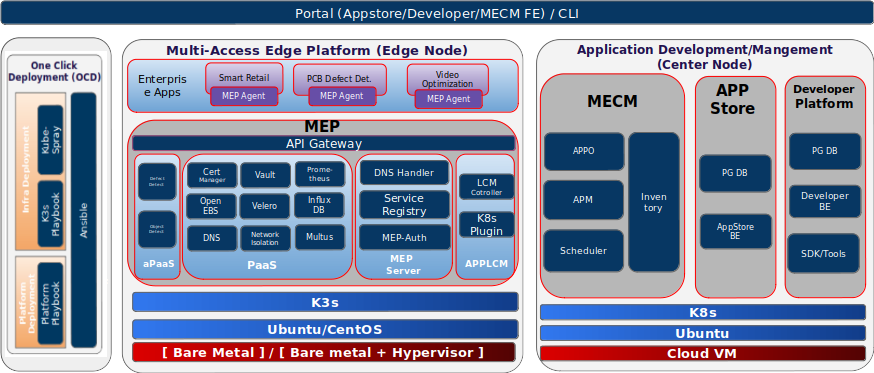Table of Contents
Blueprint
...
Overview
Introduction & Purpose of EALTEdge
Enterprise Application on Lightweight 5G Telco Edge is an Akraino approved a blueprint under 5G/MEC system blueprint family, which . It intends to make a complete ecosystem for provide a edge computing platform along with application orchestration & management to host enterprise applications on lightweight 5G Telco Edge Enterprise level platform. Platform which can be leveraged by various Telecom operators to give value added services to end users.
The edge layer which this blueprint targets is the Telco Edge.
Below are the high-level features which this blueprint will go on to implement in phase-wise.
- Lightweight MEP Solution
- Autonomous MEP Edge Sites.
- Unified Portal for platform management and for App developers.
- Sandbox with SDKs and tools chains for MEC app developers
- Heterogeneous deployment on Multi-Arch.
- ETSI MEC Compliant.
Use Case
Lightweight MEC platform, enable real-time enterprise applications on 5G telco edge.
Applications:
Diverse types of applications in various sectors, not limited to below:
● Gaming Applications, VR Live broadcasting
● The industrial park, Campus office etc.
● Video Orchestration and Optimization
● Latency Sensitive Application for Enterprise scenarios Etc
Use Case 1
Use Case 2
Use Case 3
Business Drivers
The EALTEdge Blueprint is for the Telco Edge, it targets the telecom operators to leverage this blueprint platform services and provide value added service, in return for better revenue generation. It also provide an Application Development Ecosystem by providing open SDK to developer community to develop application which can be tested and deployed easily on the MEP sites.
Overall Architecture
The Enterprise Applications on Lightweight 5G Telco Edge platform architecture consists of a One Click Deployment Node(OCD host), Center Node and single to multiple Edge Nodes .
Overall architecture diagram of the blueprint.
In Collaboration with Other BP in same family "5G MEC/Slice System to Support Cloud Gaming, HD Video and Live Broadcasting", this BP intend to provide Lightweight 5G telco Edge platform for Enterprise Applications. Some components which require to interconnection with 5G system, will be integrated from this BP.
Release 4 Architecture and Components are as below:
Figure 1 – EALTEdge R4 Architecture
. Provided edge computing platform and management is meant to be implemented in reference to ETSI MEC (please refer ETSI MEC for further details - https://www.etsi.org/technologies/multi-access-edge-computing) For details kindly refer "Targeted Architecture section". BP also intend to provide platform for enterprise application developers to develop, test, package & onboard their applications easily & quickly, thereby empowering developers to innovate & ship faster. Also eventually BP aims to provide platform capabilities and features like Multi-Tenancy, Network-Isolation, Dynamic Orchestration, Network Capabilities exposure, enhanced identification etc. as needed for "MEC in an Enterprise Setting"
BP plan is to leverage EdgeGallery (http://www.edgegallery.org/) as its upstream project to provide Edge Computing platform, Application Management and platform for application developers. It is also planned to leverage EdgeConnector & EdgeGateway of another BP in same BP family (https://wiki.akraino.org/pages/viewpage.action?pageId=11995699&src=contextnavpagetreemode) to enable features like dynamic & flexible traffic offloading. BP also have plans to add platform capabilities, sample enterprise applications and some features specifically needed for Enterprise use case through new development/integration of other open sources.
The edge computing platform(s) (MEP) needs to be installed at the telco edge(s) and Application development/management related components (MECM (MEO+MEPM+Edge Connector), AppStore, Developer Platform) needs to be installed in Telco's cloud (private/public). Edge computing platform (MEP) provides a platform as a service environment for running "Enterprise Applications" In order to be useful, BP requires 5G RAN & UPF to enable connectivity & have configurations based on use case need. Also 5Gc and OSS system needs to be in place with desired configurations.
Use Case
Diverse types of applications in various enterprise sectors, not limited to below:
● ROBO (Remote office branch office)
● Machine Vision related use cases
● Video Orchestration and Optimization
Use Case 1
Use Case 2
Use Case 3
Architecture
Targeted architecture
Center Node (Located at Telco Cloud)CENTER
CENTER Node consists of 3 components. MECM , AppStore and Developer Platform. MEC Manager is the central entity in the MEC system responsible for application and service deployment in an highly distributed computing environment, it provides overall view of hosts and applications deployed in the hosts.
MECM: comprises of MEO and , MEPM & Edge Connector which performs the following taskstask➢
- MEO: Maintains system level view of edges and carries out the Application orchestration to the desired Edge based on Application requirements and Edge node resource availability.
...
- MEPM: It is MEP manager which carries out application life cycle management and element management for specific Edge(s).
...
- There could be a single or multiple instances of MEPM (along with its sub-components) and it could be deployed in cloud or edge depending on deployment needs (like need for Autonomous edges etc.)
- APPLCM
- LCMController: Controls life cycle of applications
- Infra Plugins: Plugin for a specific infrastructure. Objective is to support Kubernetes & Openstack, but architecture would be extensive to add new Infra Manager with plugins.
- AppRuleMgr: Manages Traffic and DNS rules
- Edge Connector: Enable flexible traffic offloading from the aspects of control interaction with mobile network exposed capabilities.
- APPLCM
AppStore: It is like a market place for Application developer to launch their applications.
Developer platform: It is a platform for developer to carry out development and test their applications.
Edge Node (Located at Telco Edge)
Edge Node components manages the execution of various enterprise Applications, it provides various services which can be leveraged by edge applications for smooth functioning and its planned to provide additional aPaas services required for Machine Vision, Video Analytics ,
...
AppStore: It is like a market place for Application developer to launch their applications.
Developer platform: It is a platform for developer to carry out development and test their applications.
EDGE Node
Edge Node components manages the execution of various enterprise Applications, it provides various services which can be leveraged by edge applications for smooth functioning and its planned to provide additional aPaas services like Machine Vision, Video Analytics , IoT Analytics etc in future releases. The MEP sites will be a single node or a multiple node K3s Cluster, on which applications will be deployed by MECM module. The MEC Host will be hosted on a light weight OS.a light weight OS. Edge Node will comprise of following:
- aPaaS: Producer services for Enterprise applications to consume.
- PaaS: Platform services needed by enterprise application as well as platform components
- MEP Server:
- DNS: DNS server and DNS record management service
- Service Registry: Service registry and discovery, availability notifications
- Traffic Rule Control: Performs traffic rule control
- MEP Services: A mobile edge service is a service provided and consumed either by the mobile edge platform or a mobile edge application like RNI, Location, Bandwidth
- Edge Gateway: Enable the traffic offloading from the aspects of data plane with local traffic routing, traffic management and so on
By leveraging upstream projects like EdgeGallery and In collaboration with other BP in same family "5G MEC/Slice System to Support Cloud Gaming, HD Video and Live Broadcasting" (5G MEC/Slice System to Support Cloud Gaming, HD Video and Live Broadcasting Blueprint - Tentative roadmap of integration other BP is Q3 2021), this BP intends to deliver targeted architecture..
SDO Compliance/Reference
ETSI MEC
BP leverages EdgeGallery as an upstream which follows the reference architecture as defined in "section 6 Reference architecture" of "https://www.etsi.org/deliver/etsi_gs/MEC/001_099/003/02.01.01_60/gs_mec003v020101p.pdf". Following are components which are available/planned
- MEO (Mobile Edge Orchestrator): Mapping to EALTEdge MECM MEO Components
- MEPM (Mobile Edge Platform Manager): Mapping to EALTEdge MECM MEPM Components
- ME app lifecycle mgmt: Mapping to EALTEdge APPLCM component
- ME app rules & reqts mgmt: Mapping to EALTEdge AppRuleMgr component
- MEP
- Service Registry: Mapping to EALTEdge MEP-Server sub module
- DNS Handler: Mapping to EALTEdge MEP-Server sub module
- Traffic Rule Control: Mapping to EALTEdge MEP-Server sub module
EdgeGallery intends to comply with Application Enablement API as defined in ETSI MEC 011 https://www.etsi.org/deliver/etsi_gs/MEC/001_099/011/02.01.01_60/gs_mec011v020101p.pdf & present @ https://forge.etsi.org/rep/mec/gs011-app-enablement-api.
EALTEdge BP will leverage other BP in same BP family "5G MEC/Slice System to Support Cloud Gaming, HD Video and Live Broadcasting Blueprint" for dynamic Traffic routing & steering. Kindly refer that BP for any related SDO references/compliance.
Release 4 Architecture
Leverage EdgeGallery as an upstream to add following components to the Stack
- Application/MEC Edge Orchestrator
- Developer Platform & Application Store.
- Developer & Tenant Portals
- Add features like network isolation, DNS support, LB.
ROBO use case integration on EALTEdge:
- PaaS: Light weight storage. Backup and Restore (scheduled backup/ disaster recovery) for Remote sites
- aPaaS: Object Detection service for Retail store Inventory
- Example App: Retail store inventory management
Below is release 4 architecture for details kindly refer platform architecture section.
Note:
- For release 4, Kubernetes based Infra management is supported.
- In release 4 to use BP, UPF (external entity to this BP) needs to be pre-configured with DNS redirection rules and traffic rules to ensure connectivity.
SDO Compliance/Reference
ETSI MEC
BP leverages EdgeGallery v0.9 version which deliver implementation referring some part of ETSI MEC reference architecture as defined in "section 6 Reference architecture" of "https://www.etsi.org/deliver/etsi_gs/MEC/001_099/003/02.01.01_60/gs_mec003v020101p.pdf". Following are components which are available as part of release 4
- MEO (Mobile Edge Orchestrator): Mapping to EALTEdge MECM MEO Components
- MEPM (Mobile Edge Platform Manager): Mapping to EALTEdge MECM MEPM Components
- ME app lifecycle mgmt: Mapping to EALTEdge APPLCM component
- MEP
- Service Registry: Mapping to EALTEdge MEP-Server sub module
- DNS Handler: Mapping to EALTEdge MEP-Server sub module
For Application Enablement API compliance details kindly check http://docs.edgegallery.org/zh_CN/release-v0.9/Projects/MEP/MEP_Interfaces.html#mep-server
Platform Architecture
The below diagram gives a overall architecture of the Enterprise Application on Lightweight 5G Telco Edge blueprint as given in Release 4.
Note: EALTEdge Blueprint Deployment has been tested on Cloud VM and is not tested on Bare-Metal Environment. Though, theoretically deployment should work in bare metal, provided hardware and software prerequisites are met. Kindly refer R4 - Test Documentation of Enterprise Applications on Lightweight 5G Telco Edge (EALTEdge) to get details on the tested deployment.
CENTER Components
MECM:
- DashboardPortal: The dashboard provides user interface for the MECM services where edge nodes, APPLCM can be registered and apps can be distributed.
- Workflow / Policy: Provide policy to take action based on analytics like application relocation.
- Database: Open source PostgreSQL database is being used to store the information, Recommended version is 12.3.
- IAAS Adapter: Will retrieve the query MEP capabilities and KPI information from Prometheus and also upload config, remove config, instantiate, terminate,and query an application.
- Orchestrator: Provides application orchestration based on static/ dynamic host selection.
- Inventory: Maintains system level view of all Edges, including edge capabilities, deployed applications and their status etc.
- SchedulerHost Selection: Responsible for selection of host for deployment.
- Catalog: Catalogue displays the details of on hosts and applicationsPackage Manager: Maintains and manages application packages and is responsible of pushing images to edges.
- Common DB: Persistent Database.
...
- Portal: Portal provides the user interface to publish and launch App applications. and has option for user to comment on the application in comment section and give ratings.
- Appstore Services (App Distribution, App Experience): App Store services where uploading an App package and verifies the upload. Also provides features like comment/like for user experience sharing.
- PGDB Repository : Open source PostgreSQL database is being used to store the information, Recommended version is 12.3.
...
- Tools: Developer tools are used in Plugin Management, Plugin Life Cycle and grading systems making it more convenient for developers to develop applications and integrate them into the edgegallery platform.
- Workspace: Developers manage their own Application development process by creating projects or migrating projects. Developers can manage project, app package and test task management.
- PG DB: PostgreSQL database version 12.2 is being used.
- Portal: Provides user interface for application developer to interact with developer platform.
- Sandbox: Test environment for application developers to test their applications.
EDGE Node Components:
MEP:
- aPaaS:
- Defect Detection Service: This is a service to detect the defect when PCB images provided
- Object Detection Service: This service can be used by developer app for various Object detection for example Bottle detection and count for Retail store inventory.
- PaaS:
- Secret Management: Platform services and developer apps can use this service for sensitive info storing like password, cert etc.
- Cert Management: Platform services and developer apps can use this service for automate certifications management.
- Storage: Edge native storage for enterprise sites.
- Backup / Restore: scheduled backup, disaster recovery for remote sites
- DB: common DB for applications data
- Monitoring: system and apps health monitoring.
- CNI: k8s based networking for multi interface support in a POD for SFC scenarios, network policies etc.
- MEP ServicesServer:
- DNS: DNS server and DNS record management service
- Service Registry: Service registry and discovery, availability notifications
- AppLCM: applications life cycle management
- Network Isolation: Provides separation of control, management and data plan
- API Gateway: Provides secure End points for MEP services as well as producer Applications.
...
The below image shows the software platform distribution and architecture for Release 4.0.
EALTEdge Software Components
Unified CLI: Command Line Interface provides the user interface to install the EALTEdge environment.
...
- aPaaS:
- Defect Detection Service: This is a service to detect the defect when PCB images provided
- Object Detection Service: This service can be used by developer app for various Object detection for example Bottle detection and count for Retail store inventory.
- PaaS:
- Vault: Vault is a tool for securely accessing secrets. A secret is anything that you want to tightly control access to, such as API keys, passwords, certificates, and more. Vault provides a unified interface to any secret while providing tight access control and recording a detailed audit log.
- Cert Management: cert-manager is a native Kubernetes certificate management controller. It can help with issuing certificates from a variety of sources, such as Let’s Encrypt, HashiCorp Vault, Venafi, a simple signing key pair, or self signed. It will ensure certificates are valid and up to date, and attempt to renew certificates at a configured time before expiry.
- OpenEBS: OpenEBS is a Kubernetes native hyper converged storage solution. OpenEBS consumes the storage (disks, SSDs, cloud volumes, etc) available on the Kubernetes worker nodes to dynamically provision Kubernetes Persistent Volumes.
OpenEBS can provision different type of Local PV for Stateful Workloads like Cassandra, MongoDB, Elastic, etc that are distributed in nature and have high availability built into them. Depending on the type of storage attached to your Kubernetes worker nodes, you can select from Dynamic Local PV - Hostpath, Device, ZFS or Rawfile.
- Velero: Velero is an open source tool to safely backup and restore, perform disaster recovery, and migrate Kubernetes cluster resources and persistent volumes.
- Influx DB: Time series data base for user applications data.
- Prometheus Agent: cAdvisor, NodeExporter
- Multus: Support secondary interfaces for PODs in case of SFC scenarios and CNFs
- MEP ServicesServer:
- DNS: The MEP platform provides the domain name resolution services to the applications deployed in the EdgeGallery MEC, which can be utilised by the device applications in UE. MEC platform receives the DNS configurations from the MEC management, which includes the FQDN (Fully Qualified Domain Name), IP address and related entries. MEC applications can later query or modify the state of these configurations.
- MEP server: MEP platform services like service registry, discovery, DNS, traffic rules etc. MEP provides service registration, update, delete, and query related API interfaces. Applications can register, update, delete, and query services through MEP. The service registry provides visibility of the services available on the MEC server. It uses the concept of loose coupling of services, providing flexibility in application deployment. In addition, the service registry presents service availability (status of the service) together with the related interfaces and versions. It is used by applications to discover and locate the end-points for the services they require, and to publish their own service end-point for other applications to use. The access to the service registry is controlled (authenticated and authorised).
- Network isolation: Provides separation of control, management and data plane
- AppLCM: LCM controller and K8s plugin. Handles the application life cycle, where lcmController is mainly communicates with K8s plugin to upload config, remove config, instantiate, terminate,and query an application. It also provides APIs to query mep capabilities and kpi information from prometheus.
- KONG: Provides API gateway functionality along with authentication and authorisation.
...
